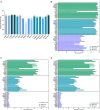Prevalence of myopia: A large-scale population-based study among children and adolescents in weifang, china
- PMID: 35958863
- PMCID: PMC9358211
- DOI: 10.3389/fpubh.2022.924566
Prevalence of myopia: A large-scale population-based study among children and adolescents in weifang, china
Abstract
Purpose: This study aimed to determine the prevalence of myopia among school-aged children and adolescents at the whole city level of Weifang, China.
Methods: This study was a large scale school-based cross-sectional study among children and adolescents aged 5-20 years old. Participants were selected by the school-based registration system in 2020. All the subjects underwent spherical equivalent (SE) error with non-cycloplegic autorefraction measurement. Myopia was defined as an SE refraction of ≤-0.75 diopters (D) and graded into low myopia (-0.75 to -3.00 D), moderate myopia (-3.01 to -5.99 D), and high myopia (≤-6.00 D).
Results: A total of 1,059,838 participants were eligible for this survey and 1,013,206 (95.6% participation rate) were selected through data quality control, which comprised 17 districts/counties and 1,254 schools, including 861 elementary schools, 313 middle schools, and 80 high schools. The mean age of participants was 11.57 ± 3.36 years (5-20 years), and the male-to-female ratio was 1.11. The whole city-level prevalence of total myopia was 75.35%. The prevalence of total myopia among the students in the Hanting District was 45.47%, but ≈82.37% of students living in Changyi have myopia. The overall prevalence of low myopia in elementary, middle, and high school students was 48.56, 47.30, and 31.62%, respectively, while high myopia (SE ≤ -6.00 D) prevalence was 1.12, 8.89, and 20.12%, respectively. The overall prevalence of myopia increased fastest in children aged 7-9 years old. The prevalence of high myopia was 7.59% for girls and 6.43% for boys, respectively (p < 0.001). The prevalence of myopia increased with increasing age and grade, but SE decreased with increasing age and grade.
Conclusions: The current investigation demonstrated a high proportion of myopia among school students in the city of Weifang, and gradually increased with age, and the prevalence of myopia was the highest in Changyi areas. The high myopia prevalence for girls was higher than that in boys.
Keywords: cross-sectional studies; large scale; myopia; prevalence; students.
Copyright © 2022 Zhang, Li, Ren, Wang, Dai, Li, Huang, Sun, Liu and Wang.
Figures


Similar articles
-
Increasing prevalence of myopia and the impact of education in primary-school students in Xi'an, north-western of China.Front Public Health. 2022 Dec 19;10:1070984. doi: 10.3389/fpubh.2022.1070984. eCollection 2022. Front Public Health. 2022. PMID: 36600934 Free PMC article.
-
The increasing prevalence of myopia in junior high school students in the Haidian District of Beijing, China: a 10-year population-based survey.BMC Ophthalmol. 2017 Jun 12;17(1):88. doi: 10.1186/s12886-017-0483-6. BMC Ophthalmol. 2017. PMID: 28606071 Free PMC article.
-
Study on the prevalence of myopia and its associated factors in China: a systemic review.Eur Rev Med Pharmacol Sci. 2023 Sep;27(17):7997-8003. doi: 10.26355/eurrev_202309_33559. Eur Rev Med Pharmacol Sci. 2023. PMID: 37750628
-
Refractive status and prevalence of myopia among Chinese primary school students.Clin Exp Optom. 2020 Mar;103(2):177-183. doi: 10.1111/cxo.12980. Epub 2019 Oct 31. Clin Exp Optom. 2020. PMID: 31674055
-
The protective role of green spaces in mitigating myopia prevalence.Front Public Health. 2024 Oct 4;12:1473995. doi: 10.3389/fpubh.2024.1473995. eCollection 2024. Front Public Health. 2024. PMID: 39430709 Free PMC article. Review.
Cited by
-
Increasing prevalence of myopia and the impact of education in primary-school students in Xi'an, north-western of China.Front Public Health. 2022 Dec 19;10:1070984. doi: 10.3389/fpubh.2022.1070984. eCollection 2022. Front Public Health. 2022. PMID: 36600934 Free PMC article.
-
The CroMyop study: myopia progression in Croatian children and adolescents-a 15-year retrospective analysis.Front Med (Lausanne). 2024 May 31;11:1405743. doi: 10.3389/fmed.2024.1405743. eCollection 2024. Front Med (Lausanne). 2024. PMID: 38882670 Free PMC article.
-
Knowledge, attitude and practice towards myopia among parents of primary school students: a cross-sectional study.BMJ Open. 2025 Mar 21;15(3):e093565. doi: 10.1136/bmjopen-2024-093565. BMJ Open. 2025. PMID: 40118481 Free PMC article.
-
Current and emerging strategies for myopia control: a narrative review of optical, pharmacological, behavioural, and adjunctive therapies.Eye (Lond). 2025 Aug 1. doi: 10.1038/s41433-025-03949-1. Online ahead of print. Eye (Lond). 2025. PMID: 40750999 Review.
-
Analysis of Refractive Errors in a Large Italian Cohort of Pediatric Subjects Post the COVID-19 Pandemic.Life (Basel). 2023 Jul 15;13(7):1569. doi: 10.3390/life13071569. Life (Basel). 2023. PMID: 37511944 Free PMC article.
References
-
- Karthikeyan SK, Ashwini DL, Priyanka M, Nayak A, Biswas S. Physical activity, time spent outdoors, and near work in relation to myopia prevalence, incidence, and progression: an overview of systematic reviews and meta-analyses. Indian J Ophthalmol. (2022) 70:728–39. 10.4103/ijo.IJO_1564_21 - DOI - PMC - PubMed
MeSH terms
LinkOut - more resources
Full Text Sources

